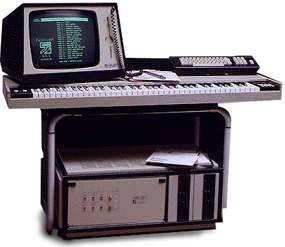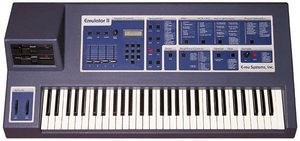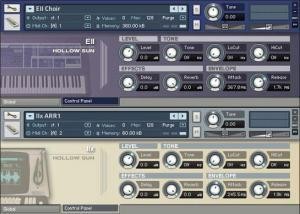Hollow Sun Vintage Samplers

Hollow Sun Vintage Samplers
Fairlight and Emu 2
To say that the Fairlight caused a sensation when it was released in 1979 would be something of an understatement. There had never been a synthesiser like it.
There had never been a synthesiser as expensive either!

The basic model was a 'mere' £17,000 going up to £25,000 with all the options installed. In other words, this was not a synth for ordinary folk. In fact, the kind of folk that did buy it were well-heeled musicians like Stevie Wonder, Thomas Dolby, Trevor Horn, the Pet Shop Boys, Vince Clark (Erasure) and Peter Gabriel.
Of course, most people associate the Fairlight with sampling but it was actually a digital synthesiser first and foremost that just happened to be able to do sampling as well.
It could do additive synthesis and you could (literally) draw waveshapes on the CRT with the light pen. It also had a sequencer and could be driven multi-timbrally with a different sound for each of the eight voices. It wasn't quite the same kind of sequencer we're used to today, however - you had to 'type' your music in using Fairlight's own MCL (Music Composition Language). It was tedious but gave you precise control over the music.
In fact, to be honest, in hindsight, sampling quality was pretty poor but that didn't stop a whole industry building up around the Fairlight - there were companies that would hire one out to you for £1,000 a day and agencies sprang up offering the services of Fairlight programmers who could earn serious money running the thing for producers who just had to have the new toy on their records.
Sampling was not uppermost in the original user interface being relegated to Page 8 of the overall operating menu and Page R - the page that probably did much to establish the Fairlight as a sequencing workstation - is right down there at the bottom... almost as an afterthought... which it was!
But however quaint this all may seem nowadays, you have to remember that at the time, this was ground breaking, revolutionary stuff... nothing like it had ever been seen before.
The Fairlight really did seem like a glimpse into the future of music making which, of course, it was - the effect the Fairlight had on the contemporary music industry just cannot be underestimated and its invention is arguably as significant as Robert Moog's original synthesisers or the invention of the electric guitar!
But the Fairlight wasn't just a hit on records - it also featured extensively on many science and music orientated TV programmes and heralded as the future of music and much like the Moog synthesiser became a household name, so too did the Fairlight. And rightly so... despite its limitations, it deserves a reverential place in music history because it literally changed the face of music as we knew it then and now.
But if the Fairlight was the first sampler, then came the Emulator.
It was a truly inspired name for a sampling keyboard (and I hope that whoever thought that name up at Emu enjoyed a very generous bonus in their pay packet!) but the original Emulator was limited with crusty sampling quality and minimal functionality and storage. In its large but distinctive wedge shaped case, the Emulator offered only very basic sampling and sample editing.

However, this all changed in 1984 with the release of the EII (Emulator 2) that took sampling to the next level with (for the time) sophisticated on-board sample manipulation and processing facilities.
The EII was 8-voice polyphonic but, unlike any sampler before, it featured resonant analogue filters and other synth features such as envelope shapers, LFOs, etc., that blurred the distinction between synth and sampler and with its (limited) multi-timbral capabilities, it (almost) qualifies as one of the first sampling 'workstations'.
For many, the EII was THE keyboard sampler to aspire to and, indeed, many did have them on their shopping list!
But the EII was not without its compromises... 8-bit (but with 14-bit playback), a 27kHz sampling rate, 512kb RAM and no hard drive (5.25" floppies only) - in this day and age, it all looks a bit crap but to put all this into perspective, the EII represented cutting edge sampling technology at the time it was released and its internal processing matched (or even exceeded) most 'home computers' of the period.
The EII's biggest problem, however, was its price - at around £10,000 it wasn't cheap and so was beyond the reach of most people. It was, of course, a big hit with artists such as the Pet Shop Boys and countless others for whom money was no object but for yer average Joe, the EII was an unattainable dream.
Of course, the EII had the wind knocked out of its sales when Akai brought out their 12-bit S900 at £1,800 a year or two later and subsequently their 16-bit stereo S1000 at £2,300 - neither products were exactly 'cheap' but they outperformed the EII at a fraction of the cost.
Emu retaliated with additions to the range. There was the EII+ (1985) that offered a dual floppy disk drive (shown above) as well as an extra 512kb of RAM but there were limitations on how this could be used - rather than having 1Mb of RAM, you had two banks of 512kb which you could switch between but you could not use both together. Then there was the EII+HD that shipped with a 20Mb hard drive. However, given the market forces at the time, there was little that the EII could do to compete with the dominance of the Akai S900/S1000.
That said, the EII was an influential product in the history of sampling and some of the sounds that were shipped with it became 'classics' in modern music history.
HOLLOW SUN has taken these classic sounds and subjected them to modern day and also proprietary sample editing techniques to take them to a new level of usability and expression in contemporary productions.
THE KONTAKT CONTROL PANEL

The control panel gives you quick and easy sound shaping capabilities.
You can modify timbre quite dramatically using the Tone control and the low- and high-pass filters. You can also delay and reverb effects and shape the amplitude envelope.
Includes Nicnt and wallaper files to add to your Kontakt library tab.
download from free file storage
Any problem with links? Click here to send me a message
CLICK HERE 4 MORE GOOD STUFF
